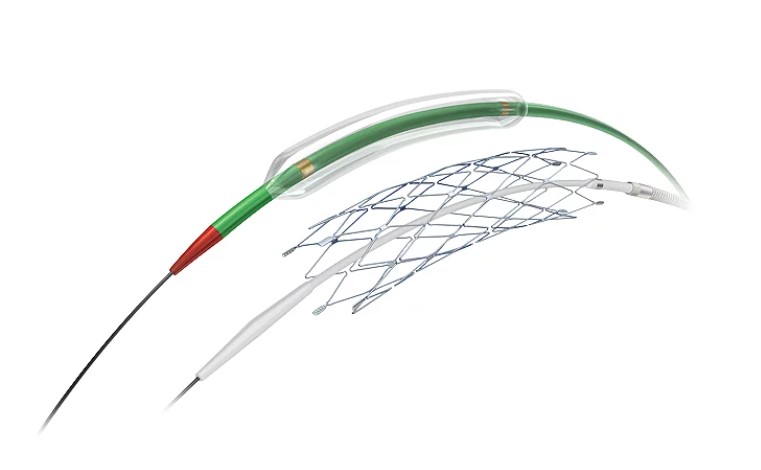Contraindications
• Patients in whom antiplatelet and/or anticoagulation therapy is contraindicated.
• Lesions that are highly calcified or otherwise could prevent access or appropriate expansion of the Stent.
• For the treatment of stroke with an onset of symptoms within 7 days or less of treatment.
• For the treatment of transient ischemic attacks.
Warnings
Contents supplied STERILE using an ethylene oxide (EO) process. Do not use if sterile barrier is damaged. If damage is found, call your Stryker Neurovascular representative. For single use only. Do not reuse, reprocess or resterilize. Reuse, reprocessing or resterilization may compromise the structural integrity of the device and/or lead to device failure which, in turn, may result in patient injury, illness or death. Reuse, reprocessing or resterilization may also create a risk of contamination of the device and/or cause patient infection or cross-infection, including, but not limited to, the transmission of infectious disease(s) from one patient to another. Contamination of the device may lead to injury, illness or death of the patient. After use, dispose of product and packaging in accordance with hospital, administrative and/or local government policy. The Wingspan Stent System is not designed or intended for contrast injections or injections other than heparinized saline. If excessive resistance is encountered during the use of the Wingspan Stent System or with the Gateway PTA Balloon Catheter at any time during the procedure, discontinue use of the System. Movement of the System against resistance may result in damage to the vessel, or a System component. In animal evaluations, the severity of vessel stenosis/ neointimal thickness appears to be correlated with the degree of trauma inflicted on the arterial walls by Stent placement or Stent radial expansion. Experience with stent implants indicates that there is a risk of restenosis. Subsequent restenosis may require repeat dilation of the vessel segment containing the stent. The risks and long-term outcome following repeat dilation of endothelialized stents is unknown at present. If the stent is implanted adjacent to or contacting other implanted metal, such as another stent or embolic coil, the metals should be of similar composition to avoid galvanic corrosion potential.
• The safety and probable benefit of the Wingspan System with Gateway PTA Balloon Catheter have not been established for treatment of patients with any of the following: – New or unstable symptoms within 24 hours of treatment; – Evidence on brain imaging study of subacute or acute ischemia in the vascular territory of the target lesion; – A recent stroke of a size that would place the patient at risk for intracranial hemorrhage; – Thrombolytic therapy within 24 hours prior to treatment with the device; – The cause of the target stenosis is not atherosclerosis; – The normal diameter of the target vessel that is not between 2.00 and 4.50 mm; – A target lesion length greater than 14 mm; – Severe calcification at the target lesion; – A minimum lumen diameter of the target vessel of less than 2 mm after pre-dilation; – Greater than 50% stenosis proximal or distal to the target intracranial lesion; OR – A previous intracerebral or intracranial hemorrhage or a recent hemorrhagic infarction Cautions / precautions General precautions
• The Wingspan Stent System and the Gateway PTA Balloon Catheter are provided STERILE for single use only. Do not resterilize. Store in a cool, dry place.
• Use the Wingspan Stent System and Gateway PTA Balloon Catheter prior to the “Use By” date printed on the package.
• Select a Stent size (length and diameter) that extends a minimum of 3 mm on both sides of the lesion. Preparation precautions
• Carefully inspect the sterile package and Wingspan Stent System prior to use to verify that neither has been damaged during shipment. Do not use kinked or damaged components.
• Typical antiplatelet and anticoagulation regimen used for interventional intracranial procedures is an important adjunct to Stent treatment. Patients must be advised to take their prescribed medications after the Stent is implanted and should be counseled on the risk of not complying with medical therapy. Instent thrombosis may occur during the procedure if proper antiplatelet and anticoagulation therapy is not administered.
• Do not steam shape the tip of the Wingspan Stent System because it could damage the Stent or Delivery System.
• Careful attention to pre-procedure anti-platelet and anti-clotting therapy (dose, type, and timing) regimen and intra-procedural anti-clotting agents is required to minimize potential post procedure complications. Procedure precautions
• Implanting a Stent may lead to dissection of the vessel distal or proximal to the Stent and may cause other complications (vasospasm/acute closure) of the vessel requiring additional intervention (i.e., further dilation, placement of stents).
• Do not deploy the Stent if it is not properly positioned in the vessel.
• Placement of the Stent may compromise side branch patency.
• Follow the Wingspan Stent System preparation and use instructions carefully.
• Previous studies have shown that some metal stents may be incompatible with MRI scanning. The Wingspan Stent has been shown to be MRI compatible in MRI systems operating at field strengths of 3.0 Tesla or lower. MRI laboratory evaluation demonstrated that no significant image distortion or heating was created by the presence of the Stents at scanning sequences commonly used during MRI procedures.
• Do not use the Wingspan Stent System or the Gateway PTA Balloon Catheter for repositioning or recapturing the Stent.
• Exercise caution when crossing the deployed Stent with guidewires or other devices.
• In tortuous vessels, a stiff guidewire may cause binding within the Wingspan® Stent System or the Gateway® Balloon Catheter during deployment. In such cases, use only soft guidewires.
• After deployment, the Stent may foreshorten up to 2.4% in 2.5 mm Stents and up to 7.1% in 4.5 mm Stents.
• Stent retrieval methods (use of additional wires, snares and/or forceps) may result in additional trauma to the vasculature and/or the vascular access site. Complications may include bleeding, hematoma, or pseudoaneurysm.

